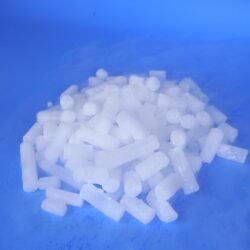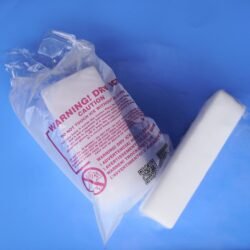Welcome to the intriguing world of dry ice! Often surrounded by an air of mystery, dry ice is not just a staple in science fiction but a fascinating substance used in various real-world applications. In this comprehensive guide, Subzero Dry Ice will dive into everything you need to know about dry ice, from its basic definition to its practical uses.
Get ready to discover some cool (quite literally!) dry ice facts and how it plays a significant role in different industries.

What is Dry Ice?
Dry ice is the solid form of carbon dioxide (CO₂), quite different from the regular water ice we’re accustomed to. Unlike water ice, which melts into a liquid, dry ice sublimates – meaning it turns directly from a solid into a gas. This unique property creates the foggy effect often seen in movies and on stage.
What Is the Dry Ice Melting Point?
Technically, dry ice does not have a melting point in the way water ice does. Instead of melting into a liquid, dry ice undergoes sublimation—it transitions directly from a solid to a gas. This happens at a temperature of -109.3°F (-78.5°C) under standard atmospheric pressure. So, when people refer to the dry ice melting point, they’re actually talking about its sublimation point.
This unique property is why dry ice leaves no liquid residue behind. It’s what makes dry ice perfect for applications that demand a moisture-free cooling solution, such as transporting electronics, medical samples, or staging fog effects for events.
The Making of Dry Ice
How Is Dry Ice Produced?
Dry ice is produced through a process that harnesses the properties of carbon dioxide (CO2). The production begins by capturing carbon dioxide gas, which is often sourced as a byproduct from industrial processes, such as ammonia production or fermentation. The CO2 gas is then compressed and cooled until it liquefies. Once in its liquid state, the pressure is suddenly reduced, causing the liquid CO2 to rapidly expand and vaporize. This rapid expansion leads to a temperature drop that freezes a portion of the liquid CO2 into solid “snow.”
This CO₂ snow is then collected and compressed into blocks or pellets, forming the dry ice we use in various applications. The process ensures that dry ice retains its unique properties, making it an essential tool in many industries.
Understanding Dry Ice Temperature
The dry ice temperature is one of the most extreme of any commonly used material, sitting at -109.3°F (-78.5°C). Unlike water ice, which melts at 32°F (0°C), dry ice bypasses the liquid phase entirely and sublimates directly into carbon dioxide gas. This property makes it uniquely suited for moisture-sensitive shipping and high-performance cooling.
This ultra-low temperature allows dry ice to preserve biological samples, maintain frozen food in transit, and cool equipment in industrial settings. It’s especially valuable in environments where refrigeration is unreliable or unavailable, such as field hospitals, outdoor events, or remote shipping lanes.
However, its extreme cold also introduces risk. Exposure to the skin can cause instant frostbite or burns, and even brief contact without insulated gloves or tongs is dangerous. For this reason, dry ice should always be stored in ventilated containers—not sealed ones—as gas buildup can lead to dangerous pressure explosions.
Dry ice temperature remains constant as long as sublimation occurs. Unlike traditional ice, it doesn’t fluctuate or create wet runoff, which means there’s no melting mess to manage. Whether you’re shipping pharmaceuticals or staging a fog-heavy concert, understanding and respecting the dry ice temperature is critical to safe and effective use.
How Long Will Dry Ice Last?
When it comes to planning cold-chain logistics or event setups, knowing how long dry ice will last is essential. Unlike regular ice that slowly melts, dry ice sublimates—turning directly from solid to gas—and how long it lasts depends on the storage conditions, insulation, quantity, and environment.
Average Lifespan by Use Case
- In a Cooler: A 10 lb block of dry ice typically lasts 24 to 36 hours in a premium insulated cooler with minimal air exchange. Basic coolers may see 18 to 24 hours of retention.
- At Room Temperature: Expect a 5 lb block to fully sublimate in 3 to 5 hours when left in open air. High temperatures and airflow reduce this lifespan significantly.
- In Transit: Professionally packed shipments with dry ice can maintain freezing temperatures for 24 to 72 hours, depending on insulation quality and shipment volume.
Factors That Impact Longevity
Several variables impact how long your dry ice will last:
- Size of the Dry Ice: Larger blocks sublimate more slowly than pellets due to a smaller surface area-to-volume ratio.
- Ambient Temperature: Higher external temperatures accelerate sublimation. In 100°F weather, expect dry ice to disappear up to 50% faster.
- Insulation: High-density containers with tight seals slow sublimation by limiting airflow and external heat intrusion.
- Air Exposure: The more you open the container, the more warm air gets in, speeding up sublimation.
Tips to Extend Dry Ice Lifespan
- Use thick-walled, insulated containers (dry ice–rated coolers or airline food transport boxes).
- Wrap dry ice in towels or foam to minimize heat transfer and airflow.
- Store in a shaded or air-conditioned space, especially in hot weather.
- Limit how often the container is opened to reduce exposure to warm air.
Understanding how long dry ice will last allows you to plan with confidence—whether you’re storing temperature-sensitive vaccines or setting up fog machines for an outdoor wedding. The more controlled your environment, the longer your dry ice will perform.
How Much Does Dry Ice Cost?
Dry ice prices vary based on quantity and supplier. At grocery or retail stores, expect to pay between $1.50 to $2.50 per pound. Industrial suppliers may offer bulk rates ranging from $0.50 to $1.00 per pound. Sub Zero Dry Ice offers competitive pricing and reliable supply tailored to commercial, medical, and personal needs.
Dry Ice Density
The dry ice density plays a crucial role in its applications. Dry ice, the solid form of carbon dioxide (CO2), has a density ranging between 1.2 and 1.6 kg/dm³. This makes it significantly denser than water ice, allowing it to sink in water rather than float. The high density of dry ice also contributes to its ability to last longer in storage, making it a preferred choice for industrial cooling and shipping applications. The dense structure of dry ice enables it to retain its cold temperature, sublimating slowly, which makes it ideal for preserving perishable goods during transport or keeping items frozen for extended periods.
Dry Ice vs Ice
When comparing dry ice vs ice, it’s important to consider their temperature, duration of effectiveness, and how they work in different scenarios. Regular ice, made from frozen water, has a freezing point of 32°F (0°C), while dry ice is much colder at -109.3°F (-78.5°C). This vast temperature difference makes dry ice far more effective at keeping items frozen for longer durations. Another key difference is that regular ice melts into water, while dry ice sublimates, turning directly from a solid into a gas. This sublimation process leaves no liquid residue, making dry ice the preferred choice for applications where moisture can be a problem, such as in electronics or sensitive food items.
Can You Mix Dry Ice with Regular Ice?
Yes, you can mix dry ice with regular ice, but it’s important to follow safety precautions. Mixing dry ice with regular ice can enhance the cooling effect, keeping items colder for longer. Dry ice, being much colder than regular ice, helps maintain lower temperatures, while regular ice provides a buffer for gradual thawing. However, it’s important to ensure proper ventilation, as dry ice sublimates into CO2 gas, which can pose a risk in confined spaces. When using both types of ice, it’s recommended to place the dry ice on top of the regular ice to maximize cooling efficiency without causing frostbite when handling the contents.
Regular Ice vs Dry Ice
In the debate of regular ice vs dry ice, each has its specific use cases. Regular ice is widely available, inexpensive, and works well for short-term cooling applications, like keeping drinks cold at a picnic or in a cooler for a day. However, it melts into water, which can create a mess or damage moisture-sensitive items. Dry ice, on the other hand, is more expensive but ideal for long-term cooling or freezing due to its extremely low temperature and lack of moisture when sublimating. For shipping frozen items, preserving perishables, or industrial cooling, dry ice is the better option. However, for everyday use or where moisture is not an issue, regular ice is more convenient and easier to handle.
The Science Behind Dry Ice
The science of dry ice is both intriguing and educational. Unlike regular ice, dry ice sublimates, meaning it transitions directly from a solid to a gas without passing through a liquid phase. This sublimation occurs because of the unique chemical composition of dry ice and the atmospheric pressure at which it is stored. When dry ice is exposed to warmer temperatures, it begins to sublimate, releasing CO₂ gas.
This can be easily demonstrated through simple experiments, such as placing dry ice in water, which creates a dense, fog-like effect due to the rapid sublimation of CO₂. This fog is commonly used for theatrical effects, creating a dramatic visual impact.

Practical Applications and Safety
Dry ice’s ability to maintain extremely low temperatures and its sublimation properties make it invaluable in various practical applications. It is widely used in the transportation of perishable goods, ensuring that items such as food, pharmaceuticals, and biological samples remain at safe temperatures during transit. In addition, dry ice is utilized in industrial cleaning, where it serves as an eco-friendly alternative to traditional cleaning methods. The use of dry ice blasting effectively removes contaminants without leaving any residue, making it ideal for sensitive equipment.
While dry ice offers numerous benefits, its handling requires strict safety precautions. The extreme cold can cause severe frostbite, and the sublimation of CO₂ can lead to an accumulation of gas in confined spaces, posing a risk of asphyxiation. Therefore, it is crucial to handle dry ice in well-ventilated areas and use appropriate protective equipment to ensure safe usage.
Handling Dry Ice Safely
Handling dry ice requires careful attention due to its extreme coldness and unique properties. Always use insulated gloves to prevent dry ice burns, and store it in insulated containers that are not airtight to avoid dangerous gas expansion that could cause a container to burst.
Ensure proper ventilation when using or disposing of dry ice, as it releases carbon dioxide gas which can displace oxygen in confined spaces and pose a risk of asphyxiation. To dispose of dry ice, allow it to sublimate naturally in a well-ventilated area, avoiding sinks or trash bins.
Never handle dry ice with bare hands or let it come into contact with your skin to prevent frostbite and severe skin damage. By following these safety tips, you can safely enjoy the benefits of dry ice in various applications.
Fun Facts About Dry Ice
- Known in some circles as ‘cardice,’ dry ice has multiple names reflecting its unique properties.
- In high-pressure environments, dry ice can become liquid, showcasing its versatile nature.
- The existence of dry ice was first documented in 1835 by French chemist Charles Thilorier. The formation of dry ice was first noted when a container of liquid carbon dioxide was opened.
- It’s called ‘dry’ because it sublimates, skipping the liquid phase and turning directly into gas.
- Dry ice may look like regular ice or snow, but it’s much colder to the touch.
- Typically, dry ice is available as pellets or blocks, catering to different uses.
- Dry ice has a density ranging between 1.2 and 1.6 kg/dm³, denser than water ice.
- The molecular weight of dry ice is 44.01 g/mole.
- It has low thermal conductivity, making it an efficient insulator.
- Dry ice also exhibits low electrical conductivity.
- As a nonpolar substance, dry ice has unique chemical properties.
- Interestingly, dry ice has a dipole moment of zero.
- In water, dry ice sinks to the bottom due to its density.
- Dry ice’s specific gravity is recorded at 1.56.
- It’s denser than water, explaining why it sinks in fluids.
- The white vapor from sublimating dry ice is primarily water fog, with carbon dioxide mixed in.
- In areas with heavy dry ice use, the concentration of carbon dioxide in the air increases.
- Without proper care, handling dry ice can lead to frostbite or dry ice burns. Insulated gloves are essential.
- Dry ice can displace air with carbon dioxide, creating an unhealthy environment. In areas with dry ice, you might inhale more carbon dioxide than oxygen.
- Eating or swallowing dry ice is dangerous, potentially causing internal frostbite.
- Contact with dry ice can kill skin cells, leading to injuries and cellular damage.
- Sealing dry ice in airtight containers can lead to explosive pressure buildup.
- Dry ice is ideal for places lacking mechanical cooling systems.
- In industries, dry ice is used for cleaning through a technique called dry ice blasting.
Dry ice is more than just a smoky novelty; it’s a versatile, powerful tool with applications in various fields. From its unique properties to its wide range of uses, dry ice is truly a substance worth exploring. Always remember to handle it safely and marvel at its capabilities!
Contact Subzero Dry Ice Today
For high-quality dry ice tailored to your specific needs, trust Subzero Dry Ice . Whether you need reliable cooling for meat processing, medical laboratories, or event presentations, we provide safe, efficient, and timely deliveries.
Contact us today to experience our exceptional service and elevate your cooling solutions.
Frequently Asked Questions About Dry Ice
How long will 10 lbs of dry ice last?
Ten pounds of dry ice can last about 24 to 36 hours in a well-insulated cooler. The actual time may vary based on ambient temperature and how often the cooler is opened.
How long will dry ice last in a cooler?
In most standard coolers, dry ice lasts between 18 to 24 hours. Premium insulated containers may extend this duration slightly, especially if kept in a shaded or air-conditioned space.
How long will dry ice last in 100 degree weather?
In very hot conditions—like 100°F—dry ice sublimates much faster. Expect 5 to 10 lbs to last only 12 to 18 hours, even in a cooler. Proper insulation and minimizing airflow can help slow the process.
How cold will dry ice keep a cooler?
Dry ice can keep a cooler at temperatures well below 32°F (0°C), often approaching its own surface temperature of -109.3°F (-78.5°C), depending on insulation and placement.
What happens if dry ice gets wet?
When dry ice touches water, it sublimates rapidly, producing dense fog as the CO₂ gas expands. This is commonly used for visual effects, but can also accelerate the loss of the ice.
Can you make dry ice last longer?
Yes. Use larger blocks, insulate with towels or foam, reduce airflow, and store in shaded or cooled environments to slow sublimation.
Why do you need an ID to buy dry ice?
Some suppliers require ID for dry ice purchases to confirm age and ensure the buyer understands safe handling, especially for bulk or industrial orders.
What is dry ice used for?
Dry ice is used for shipping frozen goods, medical transport, industrial cleaning (dry ice blasting), stage effects, and emergency refrigeration.
Can dry ice freeze water?
Yes, dry ice is cold enough to freeze water almost instantly upon contact. The extreme temperature can also cause the water to bubble and fog as CO₂ gas escapes.





